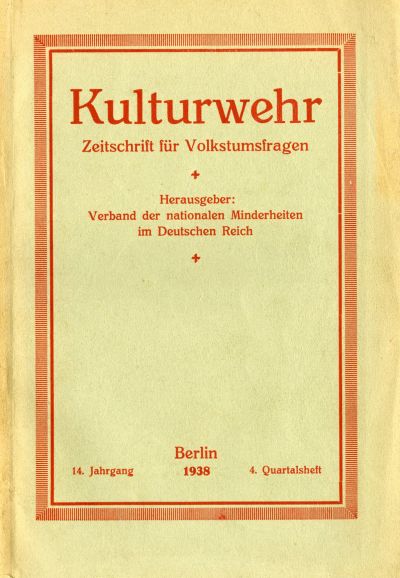The Lexicon of Polish life in Germany

One of the most important projects undertaken by the Union of Poles in Germany was the preparation and printing of the “Lexicon of Polish Life in Germany”. The idea for the project was born around 1930 when restrictions were being increasingly imposed on the social and cultural life of Poles in Germany. The council of the Union decided to collect material on the geographical distribution of Poles in Germany, and the social, cultural and economic life of the Polish Diaspora. In addition they were interested in extending this material with information about demonstrations against Poles. An editorial team was quickly set up. Despite many difficulties, including financial problems, work on the lexicon was completed in 1938. Nonetheless the book was not printed in Poland because the Foreign Office feared that this could muddy German-Polish relationships. The book was finally printed in Opole. That said the outbreak of war prevented the project from being entirely completed. The whole edition was confiscated and destroyed by the Nazi authorities. A reprint of the rescued book first appeared in Poland in the 1970s. The lexicon is an important source on the destiny of Poles in Germany in the second half of the 1930s.
The increasing violation of the rights of Poles living in Germany, the alleged deliberate reduction of their numbers in the census of 16th April 1933 and finally the destruction of their property (particularly after Hitler’s seizure of power) motivated the Central Union of Poles in Germany (ZPwN) to document the riots in a card index. In this way the organisation attempted to rescue texts and pictures on Polish life in Germany from destruction.
In order to meet this aim a special department was set up in early 1933. This consisted of Jan Łangowski and Stefan Murek, assisted by the typists Eleonora Bednarkiewicz and Helena Lehr. Edmund Osmańczyk and Edmund Kaczmarek joined the department in autumn 1933. Financial problems meant that the department was unable to take on any further staff. The existing staff were dependent on the help of Poles, above all their fellow countrymen who were studying in Germany. The group wanted to record all the places where Poles had lived. In addition they were interested in their cultural life and also made a particular note of Polish monuments. During the work someone came up with an idea for a lexicon, i.e. an alphabetical list of places with reference to the aspects mentioned above. When they were trying to put together the different Polish places they encountered difficulties because of their German names. For this reason it was agreed that all German place names with a Polish equivalent would only be quoted with a note, e.g.: “Borek, German name Walddorf until 1935, a village in the district of Kluczbork, Opole Silesia. Number of Poles according to the 1910 census: 158 (XVI, XXVIII)”. The Roman numbers point to the Polish and German sources, a list of which was to be printed at the end of the lexicon. (This list has been lost).
The foundation of the Slavic Bank (Bank Słowiański) in Berlin in 1934 changed the financial situation of the Union of Poles in Germany. It also had an effect on the work of the editors of the lexicon because the bank provided them with the means to finance their project. One year later in the press headquarters of the Union of Poles in Germany a photo department was set up with Aleksander Kraśkiewicz and Stanisław Otto Kałus, and it was not long before the first photos were available to the editors. In 1935 the department moved to new rooms in Potsdamer Straße, and this made the work on the lexicon considerably easier. The upshot was a more precise definition of the contents of the lexicon. Now the register of local places was extended by a general factual register.
In autumn 1935 Edmund Osmańczyk became the editor-in-chief and the editorial team was gradually joined by new staff. In this connection it is important to point out that all the staff were very young (average age 19-22) and had no specific training for the job. Very often the staff would ask for advice from older members of the Union. The work itself often had to be done clandestinely in order to avoid the notice of the German authorities. Parallel to this the council of the Union was closely recording German intrusions and violations of minority rights of the Polish population in order to publish them in “Kulturwehr”. The information was also included in the lexicon, which explains the many legal articles and memoranda to be found there. The mobilisation law of 16th March 1935 interrupted the work on the lexicon. Much of the work planned for 1936-37 – like sifting and collecting statistical data from the Prussian archive – could not take place and this left a gap in the register of local places. The areas they examined included West and East Prussia and Opole Silesia. Other areas were not considered. A close look at the results from the different censuses reveals many shortcomings in the lists. Hence the staff working on the lexicon concentrated on ascertaining the true number of Poles living in Germany.








